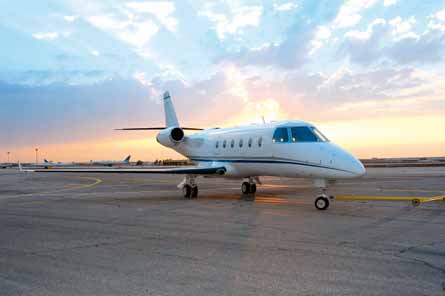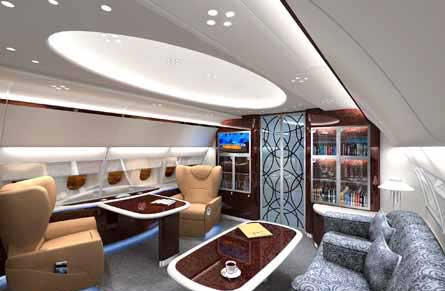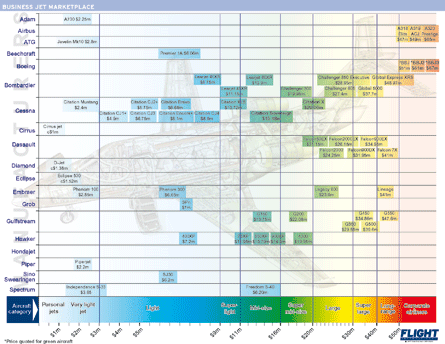Business aircraft production is booming, but numbers of clean-sheet designs are at their lowest for years. What exactly are the manufacturers up to?
These are bullish times for business aviation. The ebullient airframers with their mounting orders and lengthy backlogs are basking in the one of the brightest periods in the industry's history.
The stability of the US economy, particularly the strong corporate profits to which business aviation growth is indelibly linked, has been key in sustaining industry growth. However, the booming economies of international markets such as China, Europe, India and Russia are creating a frenzy of activity among manufacturers keen to exploit the unprecedented demand for business aircraft.
|
|---|
Gulfstream last August boosted its line-up with the mid-size G150, developed with Israel Aerospace Industries |
Aviation analyst Teal Group in its latest market forecast predicts deliveries of 12,000 business jets worth $173.2 billion over the next 10 years, marking the fourth consecutive year of business aircraft market growth, it says. "High corporate profits, business globalisation, high commodity prices, and emerging market growth, are producing another all-time market high this year - 999 aircraft worth $16.4 billion -with further growth expected into 2009."
Then "there will be a modest market dip, but this industry looks set to remain considerably larger than before its pre-1996-2001 transformation, when it experienced 350% growth."
New entrants
Forecast author and analyst Richard Aboulafia suggests that business jets are the only aviation segment with significant new market entrants "due to a combination of sufficiently high growth rates and low barriers to entry". He says margins in this segment of the aviation industry tend to be higher than the other segments, but this is changing. "Much of the industry's growth has been due to fractional ownership companies, which are better able to exert pricing pressure on manufacturers," he adds. "Also, manufacturers are concentrating increasingly on price point management, which implies a less glamorous approach to models and marketing."
With profit margins coming under pressure, airframers have become reluctant to sacrifice the cash cow to fund new all-new designs and this has resulted in the lowest rate of clean-sheet aircraft launches for years. Aircraft upgrades have become the softer and less risky option for airframers striving to woo an increasingly demanding customer base with the latest array of technologies on the market.
Bombardier's last all-new platform was the Challenger 300 super mid-size business jet launched seven years ago. Two years later, in the depths of a recession, the super-large Global 5000 and Learjet 40 light business jets, both variations of existing aircraft, were unveiled.
"We took a gamble with the timing of these launches and it paid off as both aircraft have been very successful [with 25 and 68 aircraft delivered to date]," says Bombardier vice-president James Hoblyn. "If you look at our history, we have rotated programmes every five to seven years after service entry. We are looking at new models that we may consider launching in the next 12 months," he adds.
|
|---|
The top end of the business jet market is typified by the Airbus A319CJ |
Hoblyn remains tight-lipped on product development, but Bombardier is known to be mulling over a larger-cabin, more-powerful ultra-long-range Global XRS. Hoblyn says the manufacturer is "watching closely development of the Grob Aerospace SPn light jet" programme, in which it is believed to have expressed an interest.
Hoblyn points to Bombardier's success in gaining a foothold in every business jet category from light to ultra long range and says its latest product - the upgraded mid-size Learjet 60XR - is earmarked for service entry next month. Similarly, deliveries of the large-cabin Challenger 605, Bombardier's latest upgrade of its best-selling business jet, will be stepped up in the coming months.
Bombardier last year delivered more than 200 business jets, helped by booming international markets, notably in the European Union and in Russia, which are expected to account for 60% of its deliveries outside the USA this year. Bombardier's in-production business jet fleet totals over 1,700 aircraft, including 320 Learjet 45/XRs 313 Learjet 60 series 116 Challenger 300s 352 Challenger 604/605s 21 Challenger 800 Series and 160 Global Express/XRS.
Also riding high, Cessna delivered 307 business jets last year, more than any other manufacturer, and with a backlog valued at over $9 billion, expects to deliver a record 375 jets this year.
Developer of the hugely successful Citation series, Cessna has handed over 5,100 aircraft since production began over 25 years ago and in the past six months alone has certificated and delivered two aircraft - the long-awaited Mustang very light jet at the bottom of its range and the Encore+ light jet, the latest derivative of the popular Citation V series.
"Cessna has introduced 21 new aircraft [across its general aviation aircraft range] in the last 10 years and has plans to develop 10 more types in the next five years," says Roger Whyte, the Wichita company's senior vice-president of sales and marketing.
These include the CJ4 light jet now under development as a replacement to the Bravo and "a natural progression in the CJ series", says Whyte. The CJ4 is a stretched derivative of the CJ3 with a modestly swept wing, uprated Williams FJ44-4A engines, which flew for the first time last month aboard a CJ2 testbed, and expanded Rockwell Collins Pro Line 21 avionics.
"The CJ4 will have greater speed, altitude and range performance than the Bravo and will make its first flight early next year," Whyte predicts, leading to certification and service entry in 2009 and 2010 respectively.
Cessna is also working on an upgrade to its popular superlight XLS business jet. When the XLS+ enters service next year it will be equipped with Pro Line 21 avionics, digital engine controls, reprofiled nose and a new interior.
On the drawing board is a large-cabin concept, a mock-up of which was unveiled late last year. If launched, as widely predicted at October's National Business Aviation Association convention in Atlanta, this will mark Cessna's foray into the large-cabin arena as a step up from its mid-size Sovereign and high-speed Citation X. Whyte says the large-cabin category would be a logical move for Cessna. "Our customers are very loyal to the Citation brand, but Cessna currently has nothing to offer customers who want a larger-cabin business jet," he says. The nine-seat large-cabin category is defined with a 7,400km (4,000nm) range at Mach 0.8 or 7,770km at lower speed.
Maximum operating speed would be around Mach 0.86, slower than the Citation X. The super mid-size business jet has proved hugely popular, with over 260 delivered to date, prompting Cessna to bolster production rates significantly last year to keep pace with soaring demand. The mid-size and large-cabin categories have become highly sought after. In their latest forecasts, engine manufacturers Honeywell, Rolls-Royce and Snecma all point to these sectors as having strong growth, particularly after 2010.
Taking advantage of this predicted upsurge, Dassault, manufacturer of Falcon business jets, has begun work on a super mid-size aircraft. Both the design and engine supplier for the "Future Falcon" are expected to be unveiled at next week's European Business Aviation Convention and Exhibition in Geneva. Dassault says the new aircraft will replace the Honeywell TFE731-powered 50EX at the bottom of its range (the 352nd and final 50X will be delivered during the next quarter) and is scheduled to enter service in 2012.
The French airframer - Europe's only representative in business aviation's big five - has consistently pitched its product line at the top end of the market and has an in-service tally of over 1,600 Falcons. In the past two years the airframer has certificated three new models - the defuelled, reduced-range 900DX and 2000DX and most recently the Falcon 7X ultra-long-range trijet for which Dassault is predicting between 400 and 500 sales and a 40% share of the long-range business jet market, in which it competes with Bombardier's Global models and Gulfstream's G550.
Joe Lombardo, Gulfstream's recently appointed president, is equally bullish about his company's prospects. He says: "The market is very strong, particularly in the large-cabin business jet arena." This is where Gulfstream competes with the G350 mid-range, G450 long-range and G550 ultra-long-range jets. "If you are looking to order a G550 today you are looking at delivery in the third quarter of 2010," he says. "This is longer than we'd like it to be so [through the expansion of the Savannah, Georgia-based manufacturing facility] we are doing the best we can to increase production and satisfy customer demand in an efficient way."
Lombardo says Gulfstream has made huge advances with its products over the last decade when only one aircraft, the GIV, was being built at its Savannah facility. The line-up also now boasts the new mid-size G150, which entered service last August and is jointly developed by Israel Aerospace Industries, and the super mid-size G200.
Lombardo will not be drawn on new product development and declines to comment on rumours that the General Dynamics-owned company is working on an upgrade of the G200 and a widebody derivative of the G550, tentatively dubbed the G600. "We cannot discuss our intentions on new products," he says. "But if you look at the company from a historical perspective, we have something new about every five to seven years. Our development is definitely geared to the large and mid-cabin aircraft."
Hawker Beechcraft, formerly Raytheon Aircraft, has been a pivotal player in the mid-size market since its acquired the BAe 125-series around a decade ago.
Since then more than 830 examples of the eight-passenger aircraft, now called the Hawker 800XP, have been delivered and the Hawker mid-size offering was expanded with the launch last year of the shorter-range 750 - pitched at the European market - and the longer-range 900XP. Both aircraft are scheduled for certification and first deliveries in the fourth quarter. Brad Hatt, Hawker Beechcraft's president for commercial sales, says the company is concentrating on bringing the-much delayed Hawker 4000 to market by September. "We plan to build 11 aircraft this year and ramp up to 24 in 2007," he says.
Hatt says the company's new owners - Goldman Sachs' investment arm GS Capital Partners and Canada's Onex - are committed to developing new products, but these are unlikely to be clean-sheet designs for the time being. "Although new designs are the lifeblood of the industry, there is risk associated with them and the timing has to be right," says Hatt. "For now we will take existing products and move them up and down the various price points based on the avionics and engines that are on the market." The company is working on further improvements to the Premier IA light jet, including a revamped interior and a quieter cabin. So far 170 Premier IAs have been delivered.
Improvements to the Beechcraft King Air family of twin turboprops are also under scrutiny. The fleet has undergone a number of enhancements in the past four years to fend off the threat from the emerging numbers of very light jets and to provide a smoother transition to the Premier and 800XP. These include the installation of Pro Line 21 as standard in the 200 and 350 and the introduction of an uprated C90GT. These enhancements have helped to boost the King Air fleet to over 6,170.
Fellow twin-turboprop manufacturer Piaggio Aero Industries has also seen strong sales of its P180 Avanti II, a revamp of the 20-year-old Avanti, and will boost the twin pusher's annual production in 2009 from 19 to 40 aircraft to keep pace with demand. Meanwhile, the Italian airframer is expected to decide this year to enter the business jet arena with an aircraft widely believed to be larger than the Avanti.
While Piaggio continues to weigh up its business jet launch, Sino Swearingen Aircraft has yet to secure the much-needed funding to ramp up production of its SJ30 light business jet, which was certificated 18 months ago after a 20-year development run. The first aircraft was delivered to US businessman Douglas Jaffe earlier this year and the second will be handed over within weeks to Sino Swearingen's UK distributor Action Aviation, which has secured 159 of Sino Swearingen's 300-order tally. The Taiwan-backed company aims to produce at least half a dozen aircraft this year.
Meanwhile, Eclipse Aviation has begun deliveries of its Eclipse 500 very light business jet in earnest, having received production certification for the aircraft this month. "We plan to deliver up to 400 aircraft this year," says Eclipse chief executive Vern Raburn. "We will pause production once we get to a rate of 83 aircraft a month." Raburn says he continues to be optimistic about the VLJ market, for which he has secured around 2,500 orders, but suggests that segments such as the air-taxi and international markets may take a while to mature. "We can't just go out there and sell lots of aircraft. It takes time and investment to put the infrastructure together and that is what we are doing," he says.
Building a support structure has not been an obstacle for Airbus and Boeing, which have blazed a trail at the top end of the business jet market with their expanding fleets of widebody business jets and VIP-configured airliners. "We have a greater interest in our products this year than we did last," says Boeing Business Jets president Steve Hill, "and we have more orders than we can satisfy."
"No region of the world is excluded in BBJ sales," he says. "The first available slot for either the BBJ, BBJ2 or BBJ3 is 2011." Hill says Boeing is continuing to look at the BBJC, which has a side cargo door, following strong interest from governments. But launch of the 737-600, a direct competitor to the Airbus A318 Elite, is unlikely for the time being, he says, due to the lack of production slots. "We are having to turn away sales," says Hill.
Nearly half the aircraft sold by Boeing last year were widebodies, including the 747-8 and 787-8/9, mainly to customers seeking to upgrade ageing 747s. "We have seven orders for the 787-8/9 and have sold out until 2014. We are also seeing interest in VIP versions of the 777," says Hill.
The market is equally buoyant for Airbus which has more than 80 orders for the Airbus Corporate Jetliner family, which as well as the ACJ and A320 Prestige includes the A318 Elite, which was launched a year ago and is earmarked for first delivery in the coming weeks. Airbus will increase the maximum take-off weight on all new ACJs to 76,500kg (168,500lb) from early next year and says it is also working on further performance enhancements to the family.
Interest is also being shown in Airbus's top-of-the-range products, of which it has sold an A330-200, an A340-300, two A340-500s and an A340-600 in the past two years, it says. In February, meanwhile, Airbus clinched its first preliminary order from an unidentified customer for a VIP-configured A380 ultra-large airliner.
Flight's EBACE page....
'198&CategoryID=10255&SlotID=8'Business aviation page....
'365'Business aviation pocket guide...
Source: Flight International


























